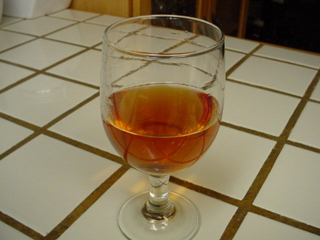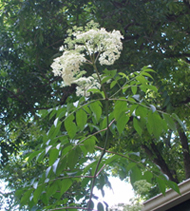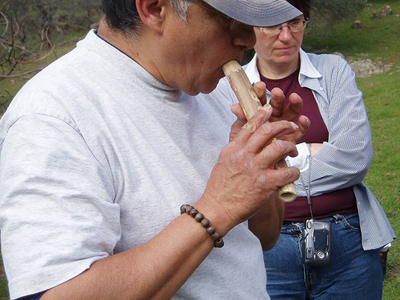Human Flower Project
Tuesday, August 07, 2007
Elderberry: Put Your Lips Together and Blow
Reading and travel to the American Midwest transport horticulturist Jill Nokes. And so does the lyricism of a familiar plant. Thank you, Jill!

Elderberry wine, also known as “Elderblow”
Photo: Chuggnutt
By Jill Nokes
I have been re-reading Willa Cather this summer in anticipation of my first trip to Kansas. I tried to imagine what that landscape had in store for me, wondering if it would be as extreme as the Texas Panhandle, or more pastoral. As it turned out, a visit to the Tallgrass Prairie National Preserve in Stone City would answer a lot of my questions, but re-reading My Ántonia renewed my admiration of Cather, her poetic and knowledgeable observations of nature, and also turned my attention to a familiar plant here at home, the common elderberry (Sambucus nigra ssp. camadensis).
In a lovely passage that is part of Jim’s (the narrator’s) last summer in his small town before leaving for college, Cather describes how he and a group of immigrant country girls he grew up with take time off to have a picnic and gather elderberry flowers.
“I had only one holiday that summer; it was in July. The elder was all in bloom now, and Anna wanted to make elderblow wine….It was the high season for summer flowers. The pink bee-brush stood tall along the roadsides, and the coneflowers and rosemallow grew everywhere. Across the wire fence in the long grass I saw a clump of flaming orange milkweed, rare in that part of the state.
“The girls had already taken their baskets and gone down the east road, which wound through the sand and scrub. I could hear them calling to each other. The elder bushes didn’t grow back in the shady ravines between the bluffs, but in the hot sandy bottoms along the stream, where their roots were always in moisture and their tops in the sun. The blossoms were unusually luxuriant and beautiful that summer. I followed a cattle path through the thick underbrush until I came to a slope that fell away abruptly to the water’s edge. A great chunk of the shore had been bitten out by some spring freshet, and the scar was masked by elder bushes growing down to the water in flowery terraces. I didn’t touch them. I was overcome by content and drowsiness, and by the warm silence about me. There was no sound but the high, sing-song buzz of wild bees and the sunny gurgle of the water beneath.
“Down there on a lower shelf of the bank, I saw Ántonia, seated alone under the pagoda-like elders.”
 Common elderberry in bloom
Common elderberry in bloom
Sambucus nigra ssp. camadensis
Photo: Jill Nokes
You can find elderberry growing from Nova Scotia south to Florida, west to the Dakotas and Texas. This loose, graceful woodland shrub belongs to the honeysuckle family and is typically found in a bar ditches old fields, and the edges of woods. Many stalks rise from a base and in early summer are topped with flat corymbs of white flowers that later become nodding clusters of dark red to black fruit. The genus name comes from the Greek sambuce, a name for an ancient musical instrument and refers to the soft interior pith which is easily removed to make flutes and whistles. Although the leaves, twigs, stems and unripe fruit contain a low toxicity, old farm journals and almanacs list many curative uses of the plant, from ointments for healing sores on animals as well as salves to “beautify the complexion” of hard-working farm wives. The prolific berries have been used for many centuries to make beautifully colored and delicious wine and jelly, though it was considered rather difficult, as it has a tendency to turn to vinegar.
In My Ántonia, the girls are using the blossoms to produce “elderblow” a beautiful pale yellow wine of delicate flavor. An old farm journal of my grandmother’s from rural New York offers this recipe: “Pack the flowers in three gallons of water with five pounds of sugar and a yeast cake to ferment for nine days. Add three pounds of raisins. Store in a cool, dark place for six months.”
As a source for a childhood whistle or the wherewithal to wet your whistle later in life, there’s always the elderberry bush.

Antonio Flores, docent with the Middle Mountain Foundation, teaches
hikers at Sutter Buttes, California, how to make flutes from elderberry
stalks. Flores said that it took him “about a year and a half” to learn
how to play one.
Photo: Courtesy of Mary Yamada




